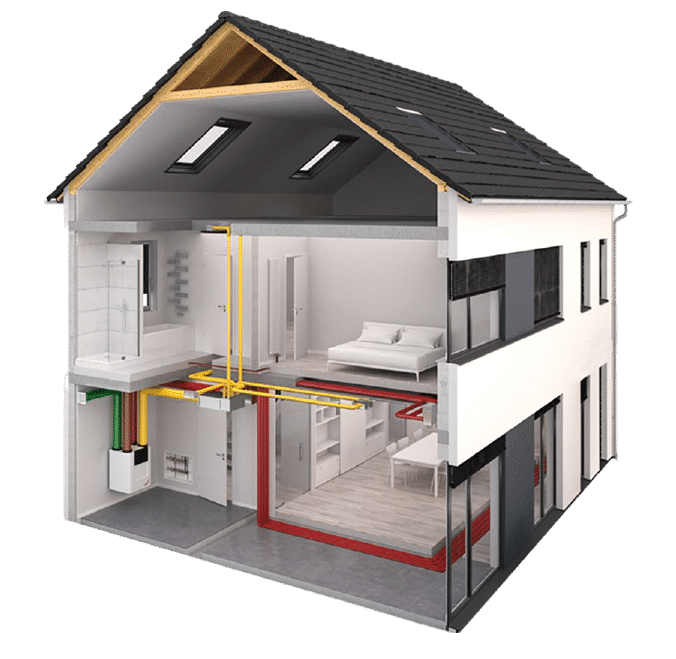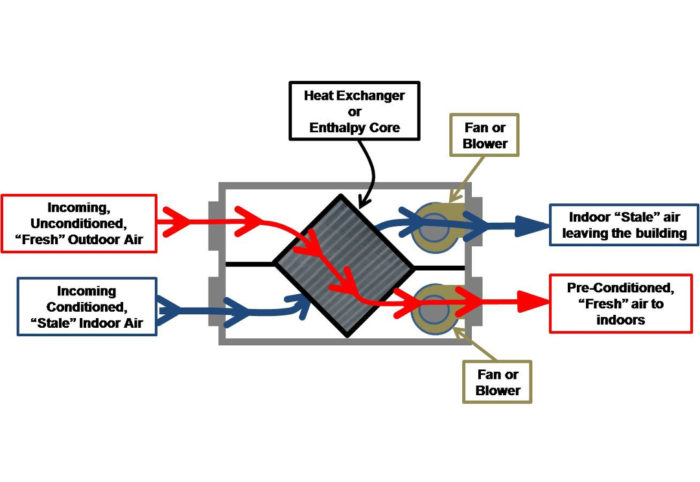Ways to Cut Costs with HRV in Variable Seasons
Wiki Article
Unveiling the Trick Conveniences and Uses of Heat Recovery Ventilation in Sustainable Design
Heat Recovery Ventilation (HRV) systems play an important function in lasting style. They help with a continuous exchange of stale indoor air with fresh outside air, greatly enhancing interior air high quality. Furthermore, HRVs contribute to power performance by reclaiming warm from worn down air, which can reduce energy expenses. Recognizing the multifaceted advantages and applications of HRVs reveals their significance in modern-day style. What various other benefits do these systems use in the quest of sustainability?Comprehending Heat Recovery Ventilation Systems
Heat recovery ventilation (HRV) systems are created to improve interior air high quality while lessening power loss. These systems make use of a mechanical air flow technique to exchange stale interior air with fresh outside air, making sure a continuous supply of clean air. By recording heat from the exhaust air, HRVs prerequisite incoming air, minimizing the demand on heating and cooling down systems. This procedure not only improves thermal convenience however additionally contributes to energy efficiency in property and business structures. Furthermore, HRV systems assist control moisture levels and lower indoor pollutants, advertising a much healthier living environment. Their strategic execution is vital for accomplishing lasting style objectives, as they offer a balance between energy preservation and resident well-being.Just How HRV Equipment Work
While several may know with air flow systems, recognizing exactly how warmth healing ventilation (HRV) systems run is crucial for appreciating their benefits. HRV systems work by exchanging stagnant indoor air with fresh outside air while moving warmth in between the two streams. This process happens in a warm exchanger, where warm from the outward bound air warms the inbound air throughout chillier months, decreasing power loss. On the other hand, in warmer months, the system can cool down inbound air making use of the cooler outgoing air. HRVs are equipped with followers to promote airflow and filters to get rid of particulates, ensuring a constant, well balanced ventilation process. This innovative layout not only boosts power effectiveness but also adds to keeping a comfy interior environment.Enhancing Indoor Air Top Quality
Indoor air top quality can considerably influence wellness and wellness, making reliable ventilation essential in contemporary homes. Heat Recovery Ventilation (HRV) systems play a vital duty in maintaining indoor air top quality by continually trading stale indoor air with fresh exterior air. This procedure not just lowers air-borne contaminants but additionally reduces humidity degrees, which can lead to mold and mildew growth and respiratory system problems. HRV systems filter inbound air, removing irritants and particulates, thereby giving a healthier living setting. Additionally, these systems assist eliminate smells and volatile organic substances (VOCs) typically located in home items. By guaranteeing a consistent flow of tidy air, HRV systems contribute to a total better indoor environment, advertising convenience and well-being for passengers.Energy Efficiency and Expense Financial Savings
Power performance attracts attention as a significant benefit of Heat Recovery Ventilation (HRV) systems. By catching and recycling the warm from worn down interior air, HRVs decrease the power needed for home heating inbound fresh air, resulting in decreased power usage. This effectiveness converts into lower energy costs, providing substantial price savings for home owners and companies alike. Furthermore, HRV systems usually receive power performance motivations and refunds, even more boosting their economic appeal. Over time, the preliminary financial investment in HRV technology can bring about a favorable return on financial investment through lowered power costs. The integration of HRV systems not just promotes sustainable layout yet additionally supplies a useful service for achieving lasting energy cost savings and economic benefits.Environmental Advantages of HRV

A multitude of ecological advantages emerges from the execution of Heat Recovery Ventilation (HRV) systems. By successfully transferring warm from exhaust air to inbound fresh air, HRVs significantly minimize the energy required for heating and cooling down rooms. This power effectiveness equates to reduce greenhouse gas emissions, adding to a decline in the general carbon footprint of structures. Furthermore, HRV systems boost interior air top quality by continuously flowing fresh air, consequently minimizing the focus of interior contaminants and irritants. The reduction in energy intake aids in conserving all-natural resources, making HRVs a necessary part of sustainable layout. Generally, the ecological benefits of HRVs play a vital role in promoting a much healthier world and fostering green structure methods.
Versatile Applications in Modern Architecture
Heat recovery ventilation (HRV) systems are significantly being incorporated right into both domestic and industrial architectural projects. In household setups, HRVs improve interior air quality while maximizing energy performance. At the same time, in commercial areas, these systems maximize ventilation approaches, showing their versatility in modern building applications.Residential Projects Combination
While contemporary style significantly emphasizes sustainability, the integration of warmth recovery ventilation systems in household projects has actually become a sensible remedy for enhancing indoor air high quality and power efficiency. These systems effectively move warm from exhaust air to incoming fresh air, lessening power loss and minimizing heating or cooling demands. In brand-new builds and retrofits alike, warmth recovery air flow can be effortlessly incorporated, providing property owners with a healthier living environment while reducing utility expenses. Furthermore, with enhancing awareness of environmental impacts, even more engineers and building contractors are identifying the lasting advantages of these systems. Therefore, heat recuperation air flow has actually come to be a critical part of sustainable domestic style, showcasing flexibility and commitment to eco-friendly techniques.Industrial Spaces Optimization
As modern industrial areas evolve to meet the demands of sustainability and efficiency, the application of warm recovery air flow systems becomes a crucial technique for maximizing indoor environments. These systems assist in the exchange of stale indoor air with fresh exterior air while reclaiming heat, considerably decreasing power consumption. This not only improves convenience for passengers yet likewise aids in decreasing functional expenses. Flexible applications can be observed in workplaces, retail rooms, and schools, where air top quality and temperature control are critical. Additionally, integrating warm recuperation ventilation straightens with green structure qualifications, additionally promoting ecological duty. Ultimately, embracing such systems in business architecture not only contributes to sustainability objectives however also promotes healthier, much more effective rooms for customers.
Integrating HRV Into Sustainable Style Practices
Incorporating warm recovery ventilation (HRV) systems into sustainable layout methods uses substantial advantages in power performance and interior air high quality. By utilizing HRV, designers can produce affordable services that not only reduce energy consumption yet additionally boost the overall convenience of indoor environments. This positioning with sustainability goals positions HRV as an essential component in modern-day building methods.
Energy Performance Improvement
By integrating heat recovery ventilation (HRV) systems right into sustainable layout practices, architects and home builders can considerably improve energy efficiency in modern-day buildings. HRV systems function by recording warmth from outbound stagnant air and moving it to incoming fresh air, decreasing the energy required for home heating or cooling interior areas. This procedure not only lowers reliance on typical cooling and heating systems however also decreases general energy consumption. In addition, HRV systems can help keep a regular interior temperature, lowering peak power needs. By integrating these systems, buildings can achieve significant reductions in utility expenses and carbon footprints, straightening with sustainability goals. Ultimately, HRV innovation stands for a useful solution for improving power efficiency in the developed setting, promoting more liable resource usage.Indoor Air Quality Renovation
How can warmth recuperation air flow (HRV) systems add to exceptional interior air high quality in modern-day structures? HRV systems efficiently exchange stale interior air with fresh outdoor air while recovering heat, minimizing temperature changes. This procedure reduces the concentration of Web Site interior pollutants, such as unstable natural substances (VOCs), allergens, and dampness, which can wear away air quality and effect occupant health and wellness. By additional resources keeping ideal humidity degrees and making certain a continuous supply of clean air, HRVs help develop a healthier indoor atmosphere. Additionally, these systems can be incorporated right into lasting layout techniques, promoting energy effectiveness alongside boosted air high quality. HRV Heat Recovery Ventilation. Subsequently, HRV modern technology plays an essential role in advancing overall occupant comfort and wellness in contemporary building layoutsEconomical Layout Solutions

Frequently Asked Inquiries
What Upkeep Is Required for Heat Recovery Ventilation Equipments?

Maintenance for warm recovery ventilation systems normally involves routine filter replacements, cleaning of warmth exchangers, evaluation of fans and air ducts, and making sure proper water drainage. These tasks help maintain effectiveness and lengthen the system's lifespan gradually.
Can HRV Systems Be Set Up in Existing Structures?
Heat recovery ventilation systems can certainly be set up in existing buildings. HRV Heat Recovery Ventilation. Retrofitting needs mindful planning and evaluation of the structure's format, guaranteeing compatibility with redirected here present systems while taking full advantage of power efficiency and interior air high qualityJust How Do HRV Solution Influence Sound Degrees Indoors?
HRV systems can influence indoor sound degrees by presenting sound from external sources with ventilation. Nonetheless, top quality installations commonly include sound-dampening features, minimizing noise impact while giving effective air exchange and keeping convenience inside your home.Exist Any Type Of Drawbacks to Utilizing HRV Solutions?
The disadvantages of using HRV systems include potential high initial costs, upkeep obstacles, and the opportunity of minimized indoor air quality if filters are not frequently transformed, which can bring about problems with humidity degrees.How Do I Select the Right HRV System for My Needs?
Picking the ideal heat recuperation ventilation system entails examining certain demands, such as developing size, climate, and power effectiveness goals. Additionally, assessing system attributes, installation demands, and maintenance factors to consider is crucial for peak performance and fulfillment.Report this wiki page